RPD Final Impressions (Quiz 4)
1/99
There's no tags or description
Looks like no tags are added yet.
Name | Mastery | Learn | Test | Matching | Spaced |
|---|
No study sessions yet.
100 Terms
Phase IV
Of the 5 phases for the sequence of partial denture treatment, what phase does the following happen in?
- Fabrication and delivery of RPD
- Oral and written instruction
Non-elastic
What type of impression material are the following:
- Rigid materials
- Thermoplastic
Elastomeric
What type of impression material are the following:
- Hydrocolloids
- Polysulfide (Mercaptan Rubber-Base)
- Polyether
- Silicone
- Stock
- Custom trays
Elastomeric hydrocolloids are used in which types of trays?
Irreversible hydrocolloids
Which type of elastomeric impression material has these disadvantages?
- Low tear strength
- Less surface detail
- Not dimensionally stable
- Difficult control of the length and width of impression borders (usually overextended impressions)
Irreversible hydrocolloids
Which type of elastomeric impression material has these advantages?
- Hydrophilic
- Inexpensive
- Pour well with stone
- Pleasant taste and odor
- Custom tray (for uniform thickness)
- Altered cast technique
Elastomeric- mercaptan ruber-base (polysulfide) is used in which types of trays?
Mercaptan ruber-base (Polysulfide)
Which type of elastomeric impression material has these disadvantages?
- Slow recovery from elastic deformation
- Poor long-term dimensional stability (loss of reaction byproduct)
- Unpleasant odor
Mercaptan Ruber-Base (Polysulfide)
Which type of elastomeric impression material has these advantages?
- High tear strength
- Long working and setting time (8-10min) --> better for border molding
- Acceptable accuracy
Polyether impression materials
Which type of elastomeric impression material has these disadvantages?
- Short working and setting time
- Low flexibility, stiffness
- Low tear strength
Polyether impression materials
Which type of elastomeric impression material has these advantages?
- Good accuracy
- Hydrophilic --> good wettability
silicone
Which elastomeric material can be used for all 3 trays (stock tray, custom tray, & altered cast technique)?
silicone
Which type of elastomeric impression material has these advantages?
- High accuracy
- Excellent dimensional stability
- Good tear strength
silicone
Which type of elastomeric impression material has these disadvantages?
- Expensive
- Working time 3-5 min
- Both hydrophilic and hydrophobic
3-5 min
What is the working time of silicone impression material?
silicone
Which impression material is both hydrophillic and hydrophobic?
Accurately record the...
- Remaining teeth
- Full extension and detail of the edentulous area (anterior and posterior)
What are the 2 goals of impressions?
- Pterygohamular notches
- Entire palate
What 2 features of the maxilla are KEY to capture when taking impressions?
Buccal shelves
Retromolar pads
Facial vestibule
Lingual vestibule
What are 4 KEY features needed when taking a mandibular impression?
true
T/F: Stock trays can be plastic or metal AND can be perforated or unperforated
retention of impression material
What does perforation of stock trays help with when taking impressions?
Yes
Are plastic trays used with adhesive?
No
Are metal trays used with adhesive?
Metal, plastic
_________ trays are more rigid while _________ trays bend more easily
3-5 mm
The trays needs to cover all the anatomical landmarks. When using a stock tray, how much larger than the outside surface of the residual ridge should it be?
tray too small
Why does this happen when taking impressions?
- The impression material outside of the confines of the tray will be unsupported
- Any area not covered by the tray will not be recorded
- Resulting in under-extended final impression and under-extended RPD
tray too small
What causes under-extended final impressions/under extended RPDs?
tray too big
What causes overextended final impressions?
Rope wax, modeling compound, or heating and opening the plastic/thermoplastic trays
How do you modify a stock tray?
Custom tray
If properly dimensioned stock tray is not possible, what should be fabricated?
When minimal border molding is required:
- Tooth supported cases (Class III and IV)
- Short edentulous areas and minimal bone loss (otherwise, border molding with custom tray is necessary for proper flange extension)
When should you use a stock tray?
true
T/F: A stock tray should be used when minimal border molding is required
stock tray
Which tray can you use for tooth supported cases and short edentulous areas?
III and IV
Stock trays can be used with which kennedy classes?
Alginate
When preparing to place the impression material into the tray, what material can you use for tooth-supported impression?
Border molding movements (should be minimal)
When placing alginate impression material in the oral critical areas (cingulum/occlusal rest seats' preparations), what should you do to best capture the edentulous areas?
- All anatomic landmarks are captured
- Surface areas of major connectors entirely captured
- All aspects of abutment teeth were recorded (rest seats, lingual and buccal aspects where reciprocal and retentive arms will be located)
When you remove an alginate impression, what should you look for when assess the quality?
Type V
After taking an alginate impression, you should disinfect and pour the impression immediately with what type of dental stone?
Store in 100% humidity and pour within 30-60 minutes
If you cannot pour alginate immediately, how can you store it?
tooth supported
Tooth supported or tissue supported impression?
- Taken at rest
tissue supported
Tooth supported or tissue supported impression?
- Impression taken in function
tooth supported
Tooth supported or tissue supported impression?
- Taken with no pressure
tissue supported
Tooth supported or tissue supported impression?
- Impression taken under pressure
tooth supported
Tooth supported or tissue supported impression?
- Taken with minimum support
tissue supported
Tooth supported or tissue supported impression?
- Taken with maximum support
tooth supported
Tooth supported or tissue supported impression?
- More movement can lead to loose abutments
tissue supported
Tooth supported or tissue supported impression?
- Overly displaced tissue can become inflamed, impaired accompanied with bone resorption
tooth supported
Tooth supported or tissue supported impression?
alginate can be used
true
T/F with stock trays, border molding movements are done but should be minimal
- Anatomy (presence of tori)
- Need border molding
What 2 reasons would you use a custom tray over a stock tray?
custom tray
When you have a class IV case where the flange is necessary to compensate for bone resorption, or tissue supported situations, which tray would you use for impressions?
stock tray
Stock tray or custom tray?
- Less lab time
custom tray
Stock tray or custom tray?
- More lab time
stock tray
Stock tray or custom tray?
- Less accurate
custom tray
Stock tray or custom tray?
- More accurate
custom tray
Stock tray or custom tray?
- Have anatomical limitations
Draw a line at the depth of the vestibule
Draw the outline of the custom tray; 2 mm short of the depth of the vestibule
Draw the outline of the spacer; 2 mm short of the outline of the tray. (4mm shorter than the depth of the vestibule)
What 3 areas do you draw to outline the tray on a maxilla?
2mm
How many mm short of the depth of the vestibule is the custom tray when drawing the outline?
4mm
How many mm short of the depth of the vestibule is the wax spacer when drawing the outline?
Wax spacer
ID the outline in blue:
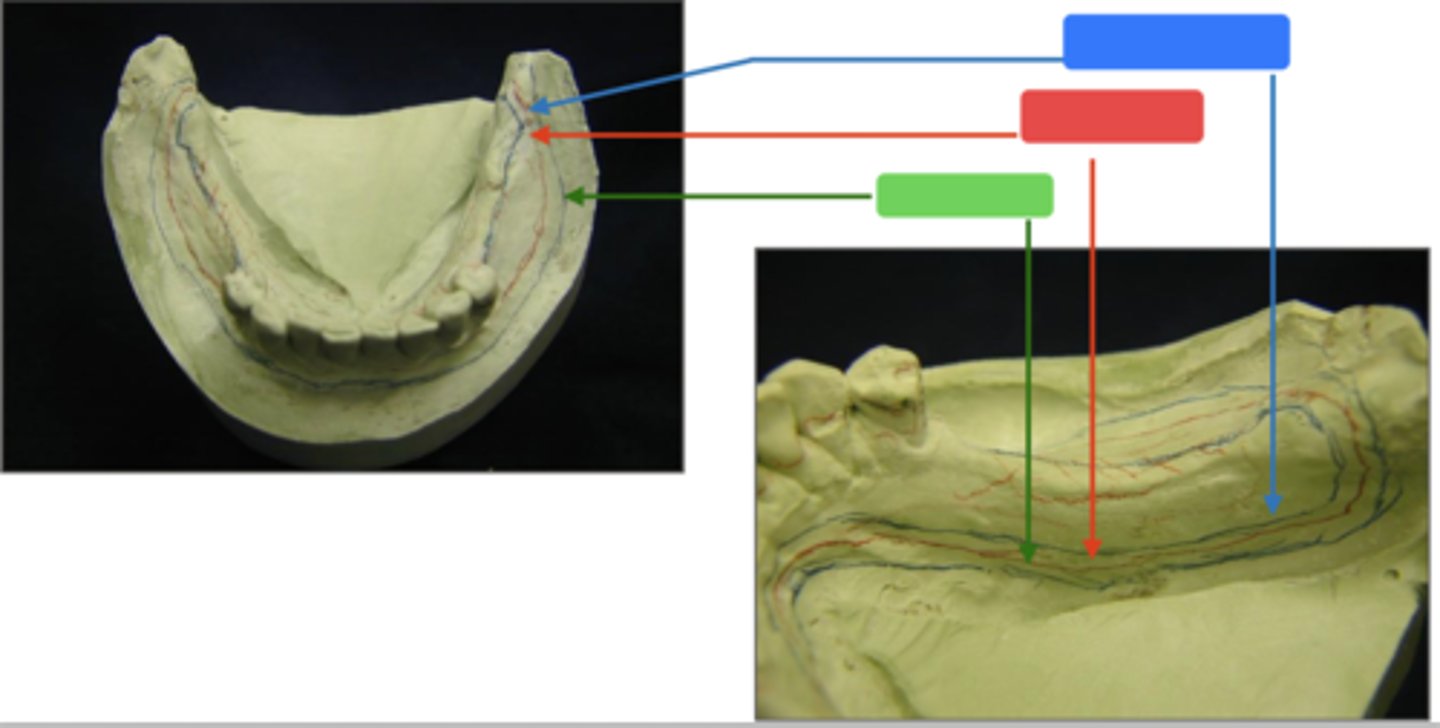
Custom tray
ID the outline in red:
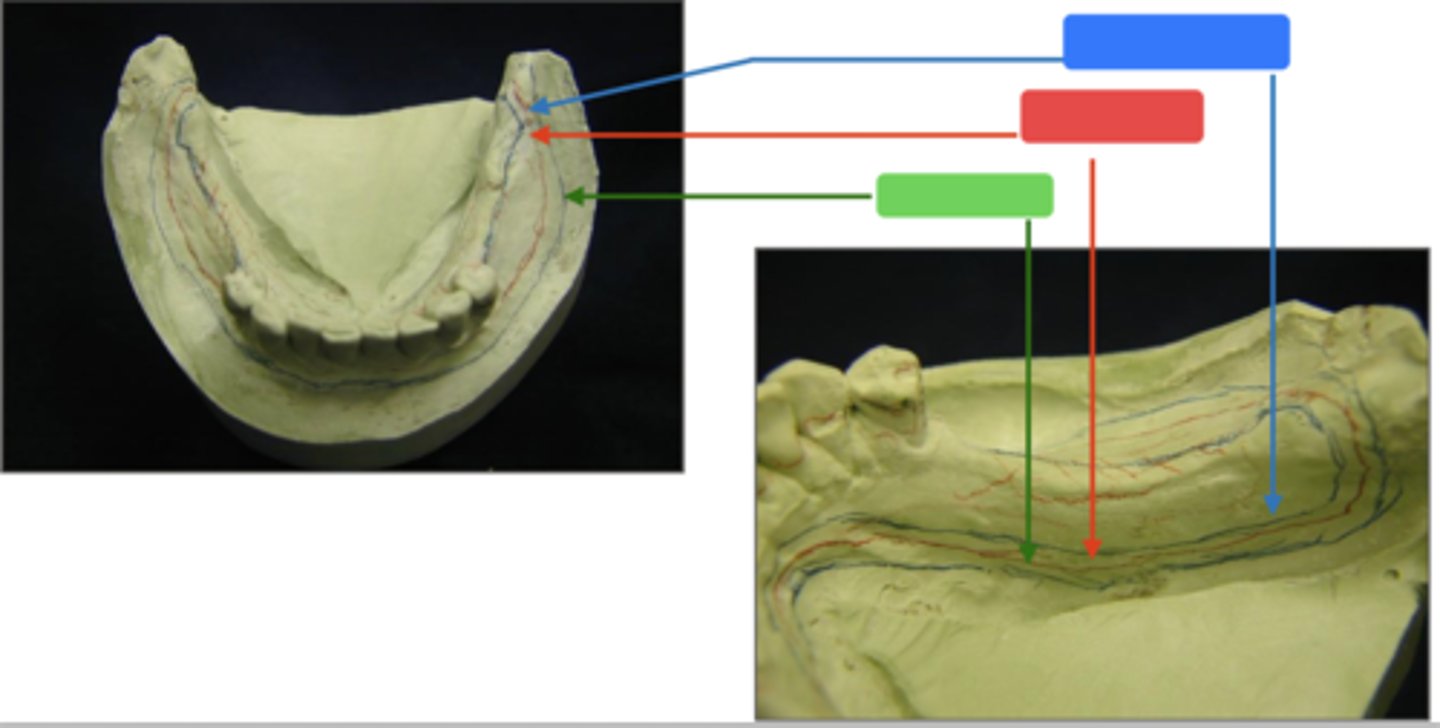
Vestibule
ID the outline in green:
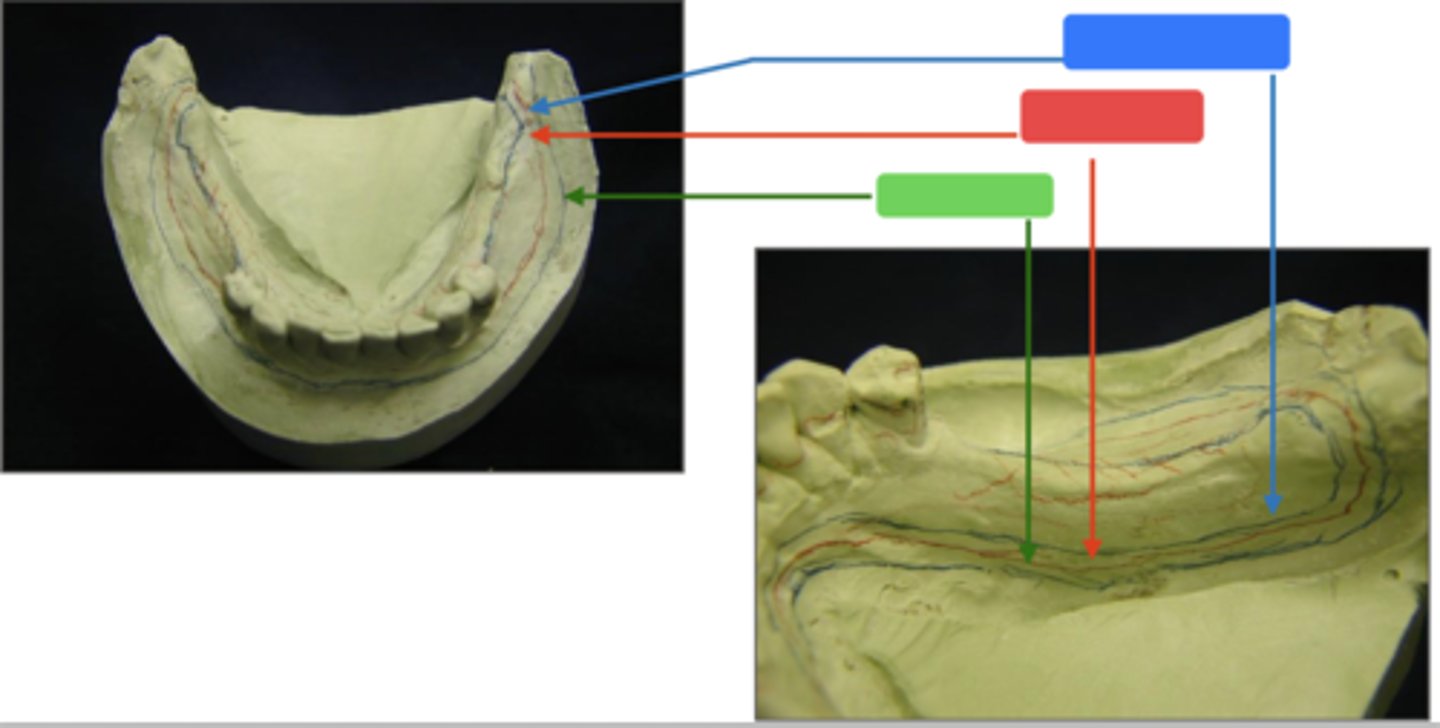
block undercuts and add wax spacer
When making a custom tray, once vaseline is applied and the cast is outlined, what is the next step?
4 mm short of depth of vestibule
When trimming excess of the baseplate wax, how much space should the wax spacer be from the vestibule?
Wax should be a little short of the line connecting the pterygo-maxillary notches
When trimming excess of the baseplate wax, how much space should the maxillary triad be from the posterior?
Yes, 1-2 additional layers
When making the custom tray, should you add extra layers of wax over teeth?
2x2 windows
What do you add to the areas where there are teeth before curing the triad to create vertical stops + maintain space for the impression material?
aluminum foil
Once the triad is complete but not cured, what do you place over the teeth areas once windows are made?
more triad
What do you fill the 2x2 windows with before curing?
- 1-2 minutes
- Turn tray over to cure intaligo for another 1-2 minutes
- Tray should be cooled by running water from time to time in order to avoid wax melting
- Final cure for about 4-5 minutes, total = 6-7 min
How long do you cure the triad tray for?
False - Remove the wax and aluminum foil only on the teeth. The rest of the wax should be maintained during border molding and removed only before taking final impression.
T/F: Remove all the wax on the cured triad for border molding
2mm
How much shorter is the triad once cured, from the vestibule?
- Buccal shelf
- Retromolar pad
What are the primary bearing areas of the mandible?
- Contour and quality of residual ridge (secondary bearing areas, firm/dense soft tissue, round ridge form)
- Denture base coverage (broader=better)
- RPD design (rest location)
- Type and accuracy of impression (viscosity of impression material, rigidity of trays, impression techniques)
- Occlusal load applied (depends on number of artificial teeth, width of occlusal tables)
- Fit of the denture base (intimate contact between intaligo of denture base and residual ridge)
What are factors influencing support of distal extension base?
Distal to mesial
For the RPD design to support distal extension base in altered cast technique, the rests are moved from _________ to _________
I and II (mandibular distal extension)
The altered cast technique is recommended for which classes on the mandible?
To capture the residual ridges in their functional form and in relation to the remaining teeth
What is the purpose of the altered cast technique (also called dual technique)?
altered cast technique
These are advantages of which impression tray technique?
- Improves fit of the denture bases
- Reduces the number of postoperative visits
- Preserves the residual ridges
- Improves stress distribution
true
T/F: The metal framework is required back from the lab in order to perform the altered cast technique
Apply triad to metal
Do border molding in new custom tray
What are the first 2 steps when using the altered cast technique once the metal framework is tried in the patients mouth?
Stock
What final impression technique is used for the blue colored images?
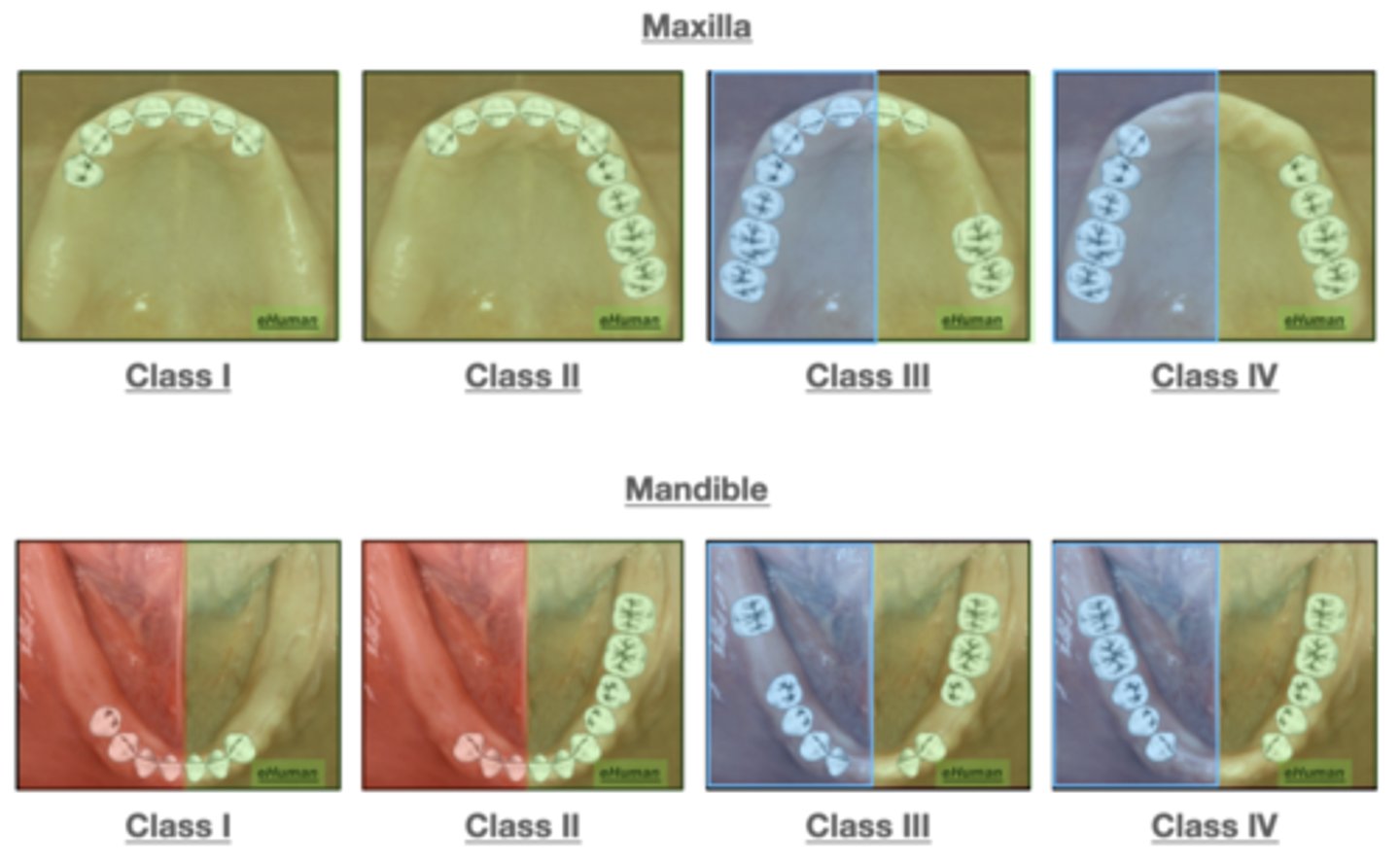
Custom
What final impression technique is used for the green colored images?
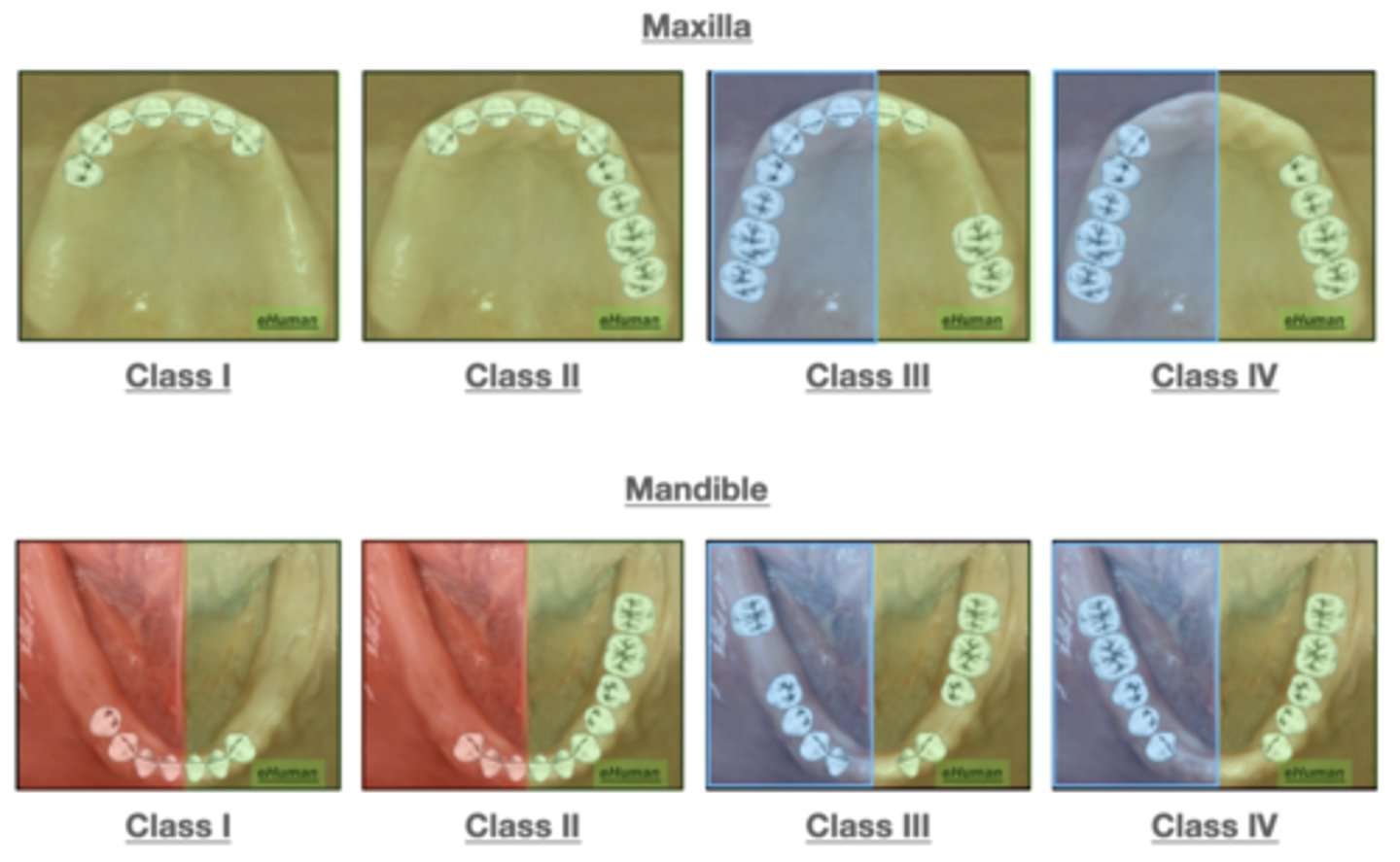
Altered cast technique
What final impression technique is used for the red colored images?
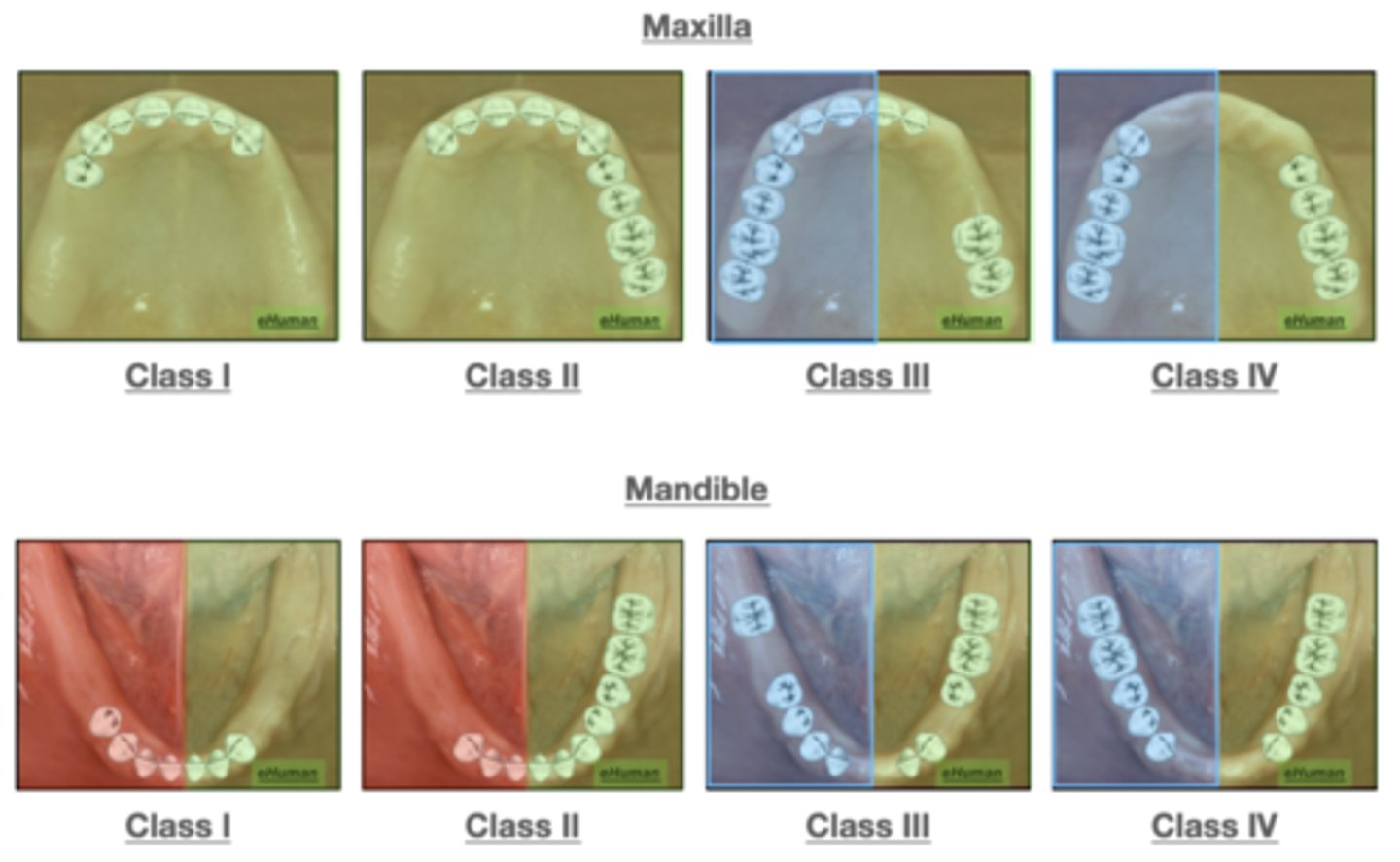
2-3mm
Once triad is added to the metal framework for the altered cast technique, the acrylic should be ___-___ mm short of the buccal vestibule
buccal frenum and shelf
Which structure is captured with border molding with these actions?
Cheek is:
- Elevated
- Pulled downward
- Pulled outward
- Pulled inward
- Pulled forward for the action of the orbicularis oris
- Pulled backward for the action of the buccinator
masseteric notch
Which structure is captured with border molding with these actions?
- Hold down the framework and instruct the patient to close his mouth hence contracting the masseteric muscle.
retromolar pad
Which structure is captured with border molding with these actions?
- Patient opens his mouth as wide as possible
mylohyoid area
Which structure is captured with border molding with these actions?
- Tongue touching the cheeks
retromylohyoid fossa
Which structure is captured with border molding with these actions?
- Ask patient to move his/her tongue forward
attach to cast (cast has cutout portion where border molding was completed)
Once border molding is done on the metal framework, what do you do with the metal framework now?
Polysulfide
What impression material is mixed and loaded into the distal extension on an altered cast technique?
roping wax
What do you attach to the impression once it is mounted back on the cast?
2-3 mm
Roping wax should be ___-___ mm above the border molding impression
3-5 mm
Roping wax should be ___-___ mm wide for land area around the border molding impression
more than 2 rows
How many rows of roping wax are necessary for the retromolar pad area?
boxing
What type of wax is added around the cast once roping wax is added?
Pour type III dental stone
What is the last step once boxing wax is set up?
Fill with cold curing resin
Check the fit of the tissue stops. If there is space under the tissue stop, what should you do?
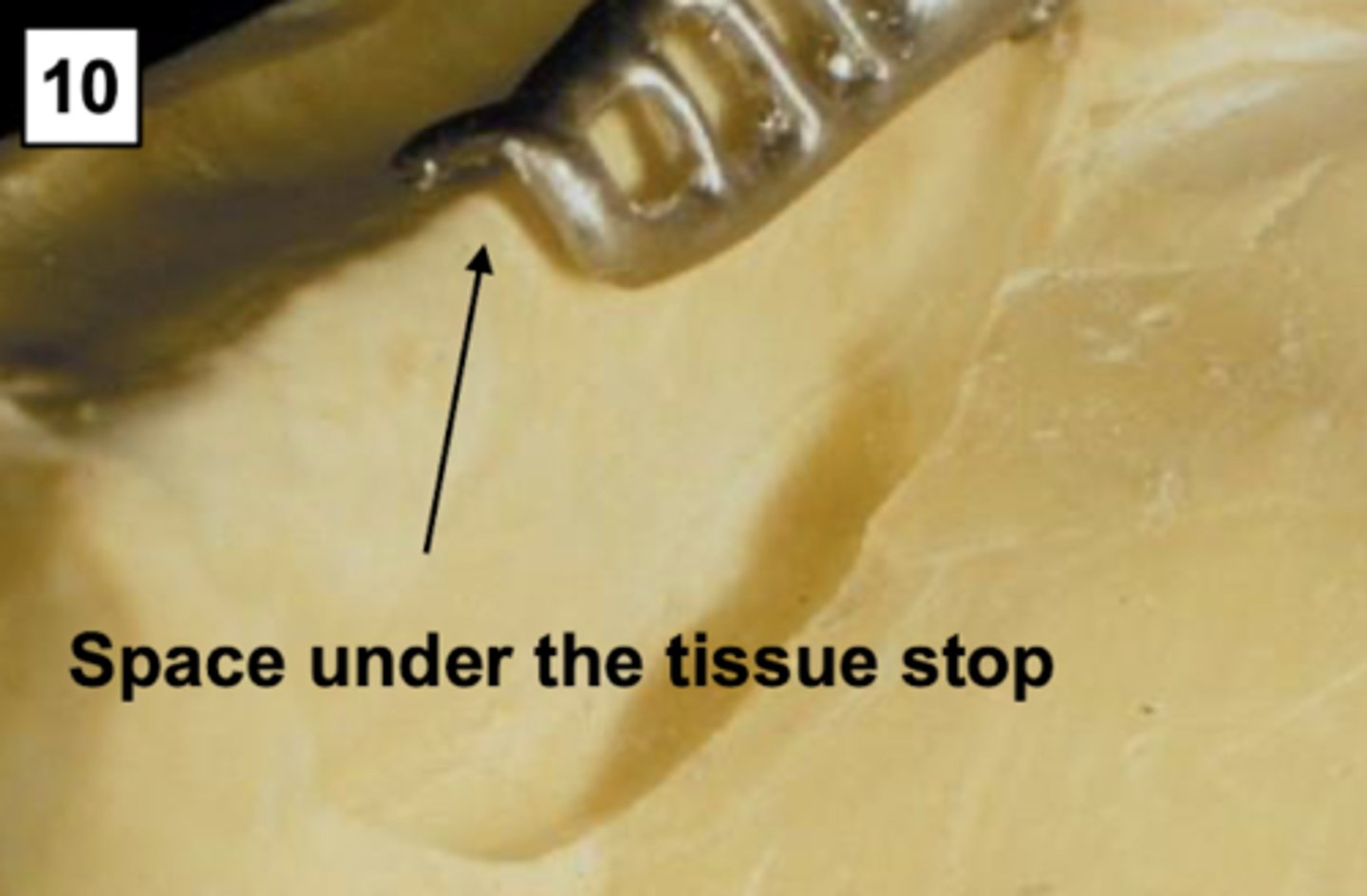
true
T/F: The altered cast technique provided the least amount of movement from the occlusal loading at the time.
true
T/F: In a one piece cast, underextension was noted in 22% of cases but no underextension was found in the altered cast impression procedure